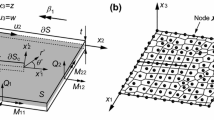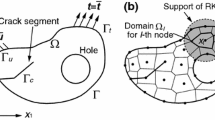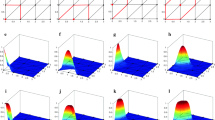Abstract
The stress intensity factors of mixed mode I–II crack loading are often evaluated numerically via FEM implementation combined with the equivalent domain integral method to derive the J k integrals. Mesh refinement or singular elements are classic techniques for reproducing the sharp stress gradient due to material fracture. In this context, high-order Bernstein shape functions are proposed for a model that couples a radial spectral expansion for the stress field around crack tip with a finite element mesh in the outer regions. Lagrange multipliers are used to enforce the coupling in displacements along the FEM–Bernstein approximations interface, in which non-matching nodal patterns are allowed.
Similar content being viewed by others
References
Rice J.R.: A path independent integral and the approximate analysis of strain concentration by notches and cracks. J. Appl. Mech. 35, 379–386 (1968)
Anderson T.L.: Fracture Mechanics Fundamentals and Applications, 2nd edn. CRC Press LLC, Boca Raton (1995)
Atluri S.N.: Path-independent integrals in finite elasticity and inelasticity, with body forces, inertia, and arbitrary crack-face conditions. Eng. Fract. Mech. 16(3), 341–364 (1982)
Lorenzi, H.G.de : On the energy release rate and the J-integral for 3-D crack configurations. Int. J. Fract. 19(3), 183–193 (1982)
Li F.Z., Shih C.F., Needleman A.: A comparison of methods for calculating energy release rates. Eng. Fract. Mech. 21(2), 405–421 (1985)
Zienkiewicz, O.C., Taylor, R.L.: The Finite Element Method. Volume 1: The Basis, 5th edn. Butterworth-Heinemann, London (2000)
Shih C.F., de Lorenzi H.G., German M.D.: Crack extension modeling with singular quadratic isoparametric elements. Int. J. Fract. 12(4), 647–651 (1976)
Dodds Jr, R.H., Vargas, P.M.: Numerical evaluation of domain and contour integrals for nonlinear fracture mechanics: formulation and implementation aspects. Report UILU-ENG-8-2006, University of Illinois, Urbana, IL (1988)
Hibbitt H.D.: Some properties of singular isoparametric elements. Int. J. Numer. Methods Eng. 11(1), 180–184 (1977)
Pian, T.H.H., Tong, P., Luk, C.H.: Elastic crack analysis by a finite element hybrid method. In: Proceedings of the Third International Conference on Matrix Methods in Structural Mechanics. Wright-Patterson Air Force Base, Ohio (1971)
Tong P., Pian T.H.H., Lasry S.J.: A hybrid-element approach to crack problems in plane elasticity. Int. J. Numer. Methods Eng. 7(3), 297–308 (1973)
Atluri S.N., Kobayashi A.S., Nakagaki M.: An assumed displacement hybrid finite element model for linear fracture mechanics. Int. J. Fract. 11(2), 257–271 (1975)
Kuna M., Zwicke M.: A mixed hybrid finite element for three dimensional elastic crack analysis. Int. J. Fract. 45(1), 65–79 (1990)
Cavalcante Neto J.B., Wawrzynek P.A., Carvalho M.T.M., Martha L.F., Ingraffea A.R.: An algorithm for three-dimensional mesh generation for arbitrary regions with cracks. Eng. Comput. 17, 75–91 (2001)
Yagawa G., Yoshimura S., Soneda N., Nakao K.: Automatic two- and three-dimensional mesh generation based on fuzzy knowledge processing. Comput. Mech. 9(5), 333–346 (1992)
Tanaka M., Hamada M., Iwata Y.: Computation of a two-dimensional stress intensity factor by the boundary element method. Arch. Appl. Mech. 52(1–2), 95–104 (1982)
Blandford G.E., Ingraffea A.R., Liggett J.A.: Two-dimensional stress intensity factor computations using the boundary element method. Int. J. Numer. Methods Eng. 17(3), 387–404 (1981)
Ariza M.P., Sáez A., Domínguez J.: A singular element for three-dimensional fracture mechanics analysis. Eng. Anal. Bound. Elements 20, 275–285 (1997)
Liu G.R.: Mesh Free Methods Moving Beyond the Finite element Method. CRC Press, Boca Raton (2003)
Fleming M., Chu Y.A., Moran B., Belytschko T.: Enriched element-free Galerkin methods for crack tip fields. Int. J. Numer. Methods Eng. 40, 1483–1504 (1997)
Rao B.N., Rahman S.: An enriched meshless method for non-linear fracture mechanics.. Int. J. Numer. Methods Eng. 59, 197–223 (2004)
Belytschko T., Krongauz Y., Organ D., Fleming M., Krysl P.: Meshless methods: an overview and recent developments. Comput. Methods Appl. Mech. Eng. 139(1-4), 3–47 (1996)
Krysl P., Belytschko T.: Element-free Galerkin method: convergence of the continuous and discontinuous shape functions. Comput. Methods Appl. Mech. Eng. 148(3-4), 257–277 (1997)
Moës N., Dolbow J., Belytschko T.: A finite element method for crack growth without remeshing. Int. J. Numer. Methods Eng. 46, 131–150 (1999)
Belytschko T., Moës N., Usui S., Parimi C.: Arbitrary discontinuities in finite elements. Int. J. Numer. Methods Eng. 50, 993–1013 (2001)
Sukumar N., Moran B., Black T., Belytschko T.: An element-free Galerkin method for three-dimensional fracture mechanics. Comput. Mech. 20, 170–175 (1997)
Rao B.N., Rahman S.: A coupled meshless-finite element method for fracture analysis of cracks. Int. J. Press. Vessels Pip. 78, 647–657 (2001)
Berger J.R., Karageorghis A., Martin P.A.: Stress intensity factor computation using the method of fundamental solutions: mixed-mode problems. Int. J. Numer. Methods Eng. 1, 1–13 (2005)
Ventura G., Xu J.X., Belytschko T.: A vector level set method and new discontinuity approximations for crack growth by EFG. Int. J. Numer. Methods Eng. 54, 923–944 (2002)
Geubelle P.H., Rice J.R.: A spectral method for three-dimensional elastodynamic fracture problems. J. Mech. Phys. Solids 43(11), 1791–1824 (1995)
Cochard A., Rice J.R.: A spectral method for numerical elastodynamic fracture analysis without spatial replication of the rupture event. J. Mech. Phys. Solids 45(8), 1393–1418 (1997)
Woo K.S., Lee C.G.: p-Version finite element approximations of stress intensity factors for cracked plates including shear deformation. Eng. Fract. Mech. 52(3), 493–502 (1995)
Rahulkumar P., Saigal S., Yunus S.: Singular p-version finite elements for stress intensity factor computations. Int. J. Numer. Methods Eng. 40(6), 1091–1114 (1997)
Lorenz, G.G.: Bernstein Polynomials, 2nd edn. Chelsea Publishing Company, New York (1986)
Fries, T., Matthies H.: Classification and Overview of Meshfree Methods. Institute of Scientific Computing. Technical University Braunschweig, Brunswick, Germany (2004)
Doha, E.H., Bhrawy, A.H., Saker M.A.: On the Derivatives of Bernstein Polynomials: An Application for the Solution of High Even-Order Differential Equations. Hindawi Publishing Corporation Boundary Value Problems (2011)
Valencia Ó.F., Gómez-Escalonilla F.J., Garijo D., López J.: Bernstein polynomials in EFGM. Proc. IMechE Part C J. Mech. Eng. Sci. 225(8), 1808–1815 (2011)
Bhatti M.I., Bracken P.: Solutions of differential equations in a Bernstein polynomial basis. J. Comput. Appl. Math. 205, 272–280 (2007)
Mirkov, N., Rasuo, B.: A Bernstein Polynomial Collocation Method for the Solution of Elliptic Boundary Value Problems. Cornell University Library (2012)
Liu, J., Zheng, Z., Xu, Q.: Bernstein-polynomials-based highly accurate methods for one-dimensional interface problems. J. Appl. Math. doi:10.1155/2012/859315
Garijo D., Valencia Ó.F., Gómez-Escalonilla F.J., López J.: Bernstein–Galerkin approach in elastostatics. Proc. IMechE Part C J. Mech. Eng. Sci. 228(3), 391–404 (2014)
Atkinson K.E.: An Introduction to Numerical Analysis, 2nd edn. Wiley, London (1988)
Raju I.S., Shivakumar K.N.: An equivalent domain integral method in the two-dimensional analysis of mixed mode crack problems. Eng. Fract. Mech. 37(4), 707–725 (1990)
Eischen J.W.: An improved method for computing the J 2 integral. Eng. Fract. Mech. 26(5), 691–700 (1987)
Nikishkov G.P., Atluri S.N.: An equivalent domain integral method for computing crack-tip integral parameters in non-elastic, thermo-mechanical fracture. Eng. Fract. Mech. 26(6), 851–867 (1987)
Shih C.F., Moran B., Nakamura T.: Energy release rate along a three-dimensional crack front in a thermally stressed body. Int. J. Fract. 30(2), 79–102 (1986)
Belytschko T., Lu Y.Y., Gu L.: Element-free Galerkin methods. Int. J. Numer. Methods Eng. 37, 229–256 (1994)
Dolbow J., Belytschko T.: An introduction to programming the meshless element free galerkin method. Arch. Comput. Methods Eng. 5(3), 207–241 (1998)
Kuna M.: Finite Elements in Fracture Mechanics; Theory—Numerics—Applications. Springer, Berlin (2013)
Spivey M.Z.: Combinatorial sums and finite differences. Discrete Math. 307, 3130–3146 (2007)
Wilson, W.K.: Research Report 69-IE7-FMECH-RI. Westinghouse Research Laboratories, Pittsburgh (1969)
Gdoutos E.E.: Fracture Mechanics: An Introduction, 2nd edn. Springer, Berlin (2005)
Rooke, D.P., Cartwright, D.J.: Compendium of Stress Intensity Factors. Stationery Office (1976)
Bowie O.L.: Solutions of plane crack problems by mapping technique. Mech. Fract. I (Methods Anal. Sol. Crack Prob.) 1, 1–55 (1973)
Nishioka T., Atluri S.N.: On the computation of mixed-mode K-factors for a dynamically propagating crack, using path-independent integrals \({J'_{k}}\). Eng. Fract. Mech. 20(2), 193–208 (1984)
Author information
Authors and Affiliations
Corresponding author
Rights and permissions
About this article
Cite this article
Garijo, D., Gómez-Escalonilla, F.J. & Valencia, Ó.F. A coupled FEM–Bernstein approach for computing the J k integrals. Arch Appl Mech 84, 1883–1902 (2014). https://doi.org/10.1007/s00419-014-0893-3
Received:
Accepted:
Published:
Issue Date:
DOI: https://doi.org/10.1007/s00419-014-0893-3




